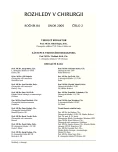-
Medical journals
- Career
Pseudolymphoma of the Breast Nipple. The Problem Overview
Authors: L. Boudová 1; D. V. Kazakov 1; O. Hes 1; B. Sůvová 2; P. Neprašová 2; V. Třeška 2; F. Fakan 1; M. Michal 1
Authors‘ workplace: Šiklův patologicko-anatomický ústav Fakultní nemocnice a Lékařské fakulty Univerzity Karlovy v Plzni, přednosta prof. MUDr. M. Michal 1; Chirurgická klinika Fakultní nemocnice a Lékařské fakulty Univerzity Karlovy v Plzni, přednosta prof. MUDr. V. Třeška, DrSc. 2
Published in: Rozhl. Chir., 2005, roč. 84, č. 2, s. 66-69.
Category: Monothematic special - Original
Overview
Clinical, pathological, and molecular-genetic features as well as etiology of cutaneous pseudolymphoma (CPL, cutaneous lymphoid hyperplasia, lymphocytoma cutis) of the breast nipple are summarized. CPL presents as a nipple induration and it is often suspected to be Paget carcinoma pre-operatively. Histologically, atypical microscopic features of a dense lymhoid infiltrate with follicles often mislead to the diagnosis of a malignant lymphoma. However, CPL runs a benign course. Rare cases of CPL contain a clonal lymphoid population. A substantial number of CPL in the breast nipple is caused by antigenic stimulation by Borrelia burgdorferi. In some patients a tick bite is documented. CPL of the breast is commonly treated by excision, but some patients may be cured by antibiotic therapy. The presence of Borrelia burgdorferi should be detected using methods of serology, culture, and molecular biology. Beside CPL, the differential diagnosis of the breast nipple lesions further includes Paget carcinoma, eczema, and florid papillomatosis.
Key words:
breast – nipple – pseudolymphoma – skin lymphoid hyperplasia – lymphocytoma cutis – Borrelia burgdorferi
Labels
Surgery Orthopaedics Trauma surgery
Article was published inPerspectives in Surgery

2005 Issue 2-
All articles in this issue
- Oesophageal Perforations
- Pseudolymphoma of the Breast Nipple. The Problem Overview
- Laparoscopic Diagnostic and Treatment of Organic Hyperinsulinism – Our First Experience
- Laparoscopy in the Colorectal Carcinoma Treatment
- Virtual colonoscopy as a part of the algorithm of the facultative examinations prior to the colorectal carcinoma procedure
- Urgent Management of the Complex Pelvic Fractures
- Hemiarthroplasty in Intracapsular Femoral Neck Fractures
- Perspectives in Surgery
- Journal archive
- Current issue
- Online only
- About the journal
Most read in this issue- Pseudolymphoma of the Breast Nipple. The Problem Overview
- Hemiarthroplasty in Intracapsular Femoral Neck Fractures
- Urgent Management of the Complex Pelvic Fractures
- Oesophageal Perforations
Login#ADS_BOTTOM_SCRIPTS#Forgotten passwordEnter the email address that you registered with. We will send you instructions on how to set a new password.
- Career

